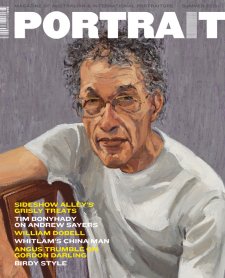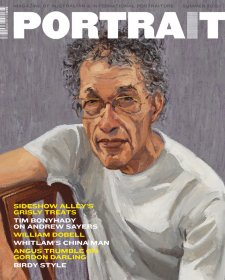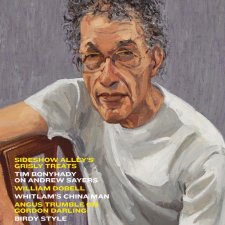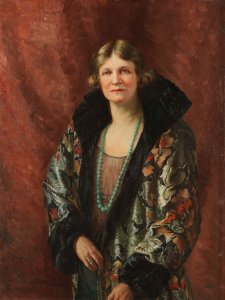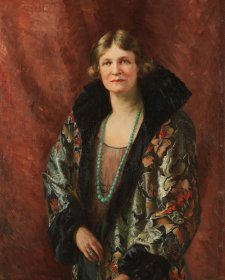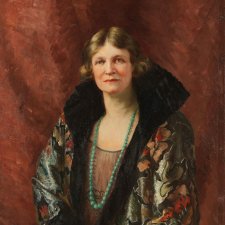In the 1990s, Australia became home to a significant number of talented Chinese artists, many of them choosing to live here because of the June 1989 massacre in Beijing. There was a concentration of them in Sydney, perhaps not constituting a ‘school’ per se, but they bonded and mingled as émigré artists are wont to do; they were taken up and promoted by a number of the same gallery owners, and some of their works have suggested an interplay of influence and inspiration.
From 1990 to 2015, remarkably, twenty-five of these artists have been finalists in the Archibald Prize, with at least one every year since 1993, and a total of more than eighty finalist paintings. It’s so large and distinctive a string of works that it warranted a retrospective in its own right - the 'Retrospective of Chinese Archibald Finalists' - earlier this year in Sydney, curated by one of the most outstanding of these painters and fourteen-times Archibald finalist himself, Jiawei Shen. In an essay for the retrospective's catalogue, former AGNSW Director Edmund Capon wrote: 'Looking back at some of the fine portraits entered by Chinese artists, I have also been intrigued by not only the sophisticated adaptation to what are generally although not entirely Western styles, but equally... of a subtle but instinctive aesthetic which makes the majority of these works recognisably Chinese.'
It may have been a political event unrelated to Australia that made us a beneficiary of this talent, but these artists settling here was also a manifestation of what was happening to us - becoming an increasingly open, ethnically mixed and cosmopolitan society. Dalu Zhao came to Australia, not in that first wave of post-1989 émigrés, but in 2001, and not for refuge. He came, in part at least, for the attraction of the Asian-Australian cultural environment which could, by then, be found here. In 2003, he approached the Conservator of Chinese Art at the AGNSW, Sun Yü, with a suggestion that he paint my portrait for the Archibald, and asked for an introduction. He knew Sun had repaired and remounted some scrolls of mine by the 19th century calligrapher, He Zizhen, and 20th century Shanghai painter, Tang Rong, father of one of my Chinese teachers. My friend and colleague, Luhua Tang, had organised this for me, and got to know Sun well. Luhua loved the idea of the portrait. She thought it would be fun to have a Chinese who’d adopted Australia as his home paint an Australian who’d adopted China as his profession, and she made the introduction. With scant time remaining for Archibald entries, Dalu set out to do the painting. We had just one sitting, in my Paddington garden for a couple of hours, chatting while Dalu sketched and his wife, Xiaoxi, a talented photographic artist, took a large number of photos. Luhua suggested the portrait be titled Lao Fei - Lao here meaning ‘old’ in the sense of respect, but also a familiar, as in old friend or old mate, and Fei, my Chinese surname.
Interviewed by reporters after his painting won the People’s Prize, Dalu said: 'He has a very interesting face and a special nose'. He didn’t say 'big', only 'special'. But with big noses part of the historic Chinese caricature of Westerners, friends reacted with hilarity. One even said my nose had now achieved recognition as a beacon in Australia-China relations. But my family and friends loved the portrait, and so did I.
Announcing the People’s Prize, Edmund Capon said it was significant that in addition to Dalu’s win, another Chinese artist had won the People's Choice prize at the Archibald Salon des Refusés. This was, as it happens, the same Jiawei Shen, with a portrait of Edmund himself. With his characteristic humour, Edmund noted: 'It’s a Chinese takeover of the People’s Choice!'
I said at the time that Dalu’s People’s Prize was an important affirmation of the place and the contribution of all of these Chinese painters to the artistic life of Sydney, a small but illustrative part of a much wider story of Australia’s coming to terms with Asia, from the White Australia in which I grew up in the 1950s to the opening of the Australian mind to Asian people, Asian influences in our daily lives, and Asian contributions to the creative and performing arts, as also in medicine, science, technology and the economy. This is a quite remarkable story of change. It’s a kind of leitmotif in my recent book, Comrade Ambassador: Whitlam’s Beijing Envoy, and I see this change as a significant turning or maturing in our history, and worth more than all the celebration people give to historical landmark events, like ANZAC, because it’s about a society that showed itself able to move from insularity and narrow intellectual horizons and racial exclusiveness towards being an open, tolerant and accepting one.
Culture has been important to this change, and I’ve always thought of a deepening of cultural enmeshment with Asia as critical to our survival and prosperity in the broader political and economic environment, a view shared by Gough Whitlam. Before setting off for Beijing as Ambassador in 1973, I proposed that we should have a dedicated cultural officer in the embassy with the relatively senior rank of Counsellor, and Gough agreed. The first appointee was Dr Jocelyn Chey, who became then, and in many later roles, a key figure in the Australia-China story.
After his previous visit in 1971 as Opposition Leader, Gough visited China as Prime Minister in October/November that year (1973), and in his talks with Chinese Premier Zhou Enlai they agreed to inaugurate an ongoing annual program of cultural exchange. This was a time when China was barely open to things foreign, in the wake of its closing down during the (singularly misnamed) Cultural Revolution, and despite Zhou’s agreement, for some years everything we proposed for our exchanges had to be turned over and upside down and microscopically examined by Chinese officials for its political acceptability.
However, it was during that visit that Gough in a symbolic way actually launched our cultural initiative in person, with a cultural event at the embassy. We had a large new work by Sidney Nolan, commissioned for the embassy building, twelve panels of paintings conceived as part of Nolan’s much larger work, Snake. Gough was to open it at a special reception for Chinese guests, but we nearly missed that altogether because shortly before the time for the reception, towards the end of the final afternoon’s talks with Zhou, Gough and I were suddenly whisked away to an historic but unscheduled meeting with Chairman Mao Zedong. I don’t think either of us thought of the Nolan during that hour-long meeting, but when it was over we rushed to the embassy to find to our relief that the guests had not gone home. So Gough launched the Nolan. Without anyone’s political approval. Coming straight from the meetings with these two figures who’d dominated the rise of modern China, I think Gough felt a particular satisfaction in being able to present, even to a limited number of Chinese people, an arresting artwork by an Australian of Nolan’s great talent and stature. The total work Snake, too large for most galleries, languished in warehouses for several decades before it was acquired by David Walsh, and is said to have been a catalyst for his creation of MONA in Tasmania.
Malcolm Fraser came to China in 1976 after defeating Whitlam at the 1975 election, and, to the surprise of many, adopted Whitlam’s China policy and indeed most of his foreign policy. And he and Andrew Peacock readily accepted our recommendation for an Australia-China Council, to ground the whole relationship in cultural understanding and exchange, enrich our own culture, and enable us to comprehend Chinese society and other Asian societies influenced by Chinese culture. Without which, we said, Australia would be damagingly ill-equipped to adjust to a China dominant in our region. Jocelyn Chey became the Council’s founding Director, and later, from 1986 to 1991, Gough himself was its Chair. The Council has funded dozens of painters in a forty-year-long run of bridging the gaps of history and culture. I feel great satisfaction in this enduring legacy.
I didn’t buy Dalu’s portrait. However much they liked it, my family said, and I conceded, that there was nowhere in the house we could hang it where they’d be able to escape a very large image of my face. Dalu took it with him when he moved to live in Melbourne, where he got to know Carrillo Gantner, actor, theatre director, philanthropist, and in the 1980s, Cultural Counsellor in the Australian Embassy in Beijing, one of the distinguished successors to Jocelyn Chey. When Dalu decided to go with his family for a long stay in Beijing, he left all his paintings with Carrillo, asking him to see if he could find buyers. Carrillo asked if I wanted to buy my portrait, and I told him my family’s initial argument was now reinforced by our move to a smaller terrace in Surry Hills. So Carrillo rang National Portrait Gallery Director, Louise Doyle, the Gallery said they’d like it, and in 2011 Dalu donated it through the Cultural Gifts Program.
The talented Jiawei Shen may not yet have won the Archibald, notwithstanding his fourteen finalist entries, but his 2006 portrait of the founding patron of the National Portrait Gallery, Gordon Darling, is on permanent display in the Gallery’s entrance hall. Regrettably, we never got a portrait of Gough Whitlam or Malcolm Fraser by one of these Chinese-Australian painters into the Archibald. Perhaps we should try to direct one of them to Jocelyn Chey.
Stephen FitzGerald’s memoir Comrade Ambassador: Whitlam's Beijing Envoy (Melbourne University Publishing, 2015) is available now.

